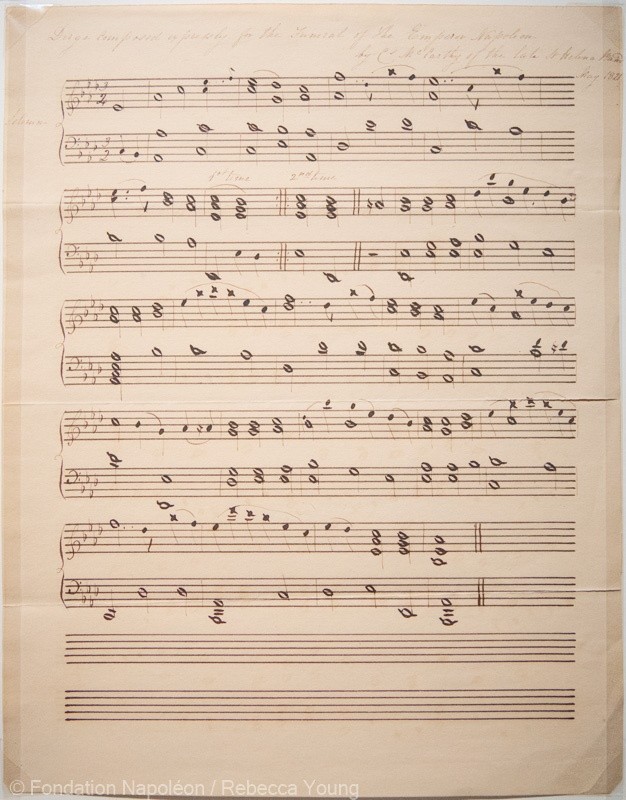It is known that during the funeral ceremony the various bands (military and island) played ‘a solemn funeral song’ (Kerr, 1822) along the route from Longwood to the valley(Tantalisingly, some fake memoirs of St Helena published in “St James’s Magazine”, vol III (April-September), 1876, p. 250, note: “Four bands belonging to different corps, playing a solemn dead march [McCarthy’s piece is not however a march], which was composed by William [sic] McCarthy, master of the St Helena band (who lives now – 1834 – at Woolwich).”). It is true that there was a lieut. Charles McCarthy (active 1780-1842) in the 66th. McCarthy was a Catholic, possibly a cousin of the regiment’s assistant surgeon, Walter Henry (author of a famous memoir), who was presented to Napoleon on 1 September 1817. McCarthy nearly lost his commission over a disagreement with Governor Hudson Lowe in 1818. His very brief diary (the manuscript of which is held at The Rifles Berkshire and Wiltshire Museum, Wiltshire, UK) records the death of “Napoleon Buonaparte on Saturday 5 May at six o’clock in the evening” and states that McCarthy was on guard over the Emperor’s tomb on 20 May 1821. Curiously, however, the diary makes no reference to either the music, the St Helena fanfare or to his composition for the funeral. And the score here makes no reference to McCarthy’s rank or regiment. Were there two Charles McCarthys, one military and one a musician?
“Coincidence? I don’t think so!”
There is also one further, tantalising problem with the situation. The score mentioned by Chaplin was in the UK owned by a “Miss Owen” in 1916, but that known today and shown here is in Paris amongst the papers of Rohan Chabot(The hand-written score, which bears the inscription “Dirge composed expressly for the Funeral of the Emperor Napoleon by Ch. McCarthy of the late St Helena Band, May 1821”, was discovered in November 2019, by Charles-Eloi Vial (curator of the manuscript department of the Bibliothèque Nationale de France) in the Rohan Chabot archive at the Fondation Josée and René de Chambrun in Paris .), who was famously present on St Helena for the exhumation of Napoleon’s mortal remains in 1840. Amongst his papers stands another musical score, that played in 1840, one which he presumably received at that time on the island. Now, it just so happens that Chaplin in his Who’s Who refers to another lady called ‘Owen’. “Mrs Owen” of Beckenham was the last survivor of those who attended the funeral of Napoleon on 9 May 1821. This lady, who died in 1916 in her ninety-fifth year in Tooting (London), was born on St Helena on 26 January 1821. She was the daughter of Captain James Bennett of the St Helena Foot Regiment, who lived at “Chubbs Springs”, not far from “The Briars”(the house where Napoleon stayed for a few months upon his arrival on St Helena in 1815). Although aged only three and a half months at the time of Napoleon’s death, her father was anxious that all his children should be able to say that they had attended Napoleon’s funeral, and accordingly Mrs Owen, as an infant, was taken to the ceremony. Naturally she remembered nothing of the event. In addition to this, Mrs Owen was also present at the exhumation in 1840, and she was one of the ladies who worked the tri-colour flag made of Chinese silk which was unfurled when the remains of the great Emperor left the island of St Helena. The other ladies who undertook this duty were Miss Mary Gideon, the Misses Pritchard, and the Misses Hammond.
Is the manuscript held in Paris that which belonged to the “Miss Owen” mentioned by Chaplin in 1916? It is possible since half of the Rohan Chabot family is Irish and anglophone. Or is it another copy, which Rohan Chabot picked up on St Helena in 1840? Unless another manuscript emerges, we will never know.
Peter Hicks, October 2021
Peter Hicks is a musician, historian and International Affairs Manager at the Fondation Napoléon.
► The first part of this text was originally published in French in the exhibition catalogue Napoleon n’est plus, Paris Gallimard/Musée de l’Armée, p.193.
Listen to a performance (5 October 2021) of this piece arranged by Peter Hicks for brass and percussion.


